Telluride Mineralogy of the Kochbulak Epithermal Gold Deposit, Tien Shan, Eastern Uzbekistan
Abstract
:1. Introduction
2. Geological Background
3. Deposit Geology
4. Samples and Analytical Methods
5. Results
5.1. Mineralogy of Tellurides
5.2. Paragenetic Succession and Mineral Chemistry
6. Discussion
6.1. Tellurides Genesis Conditions
6.2. Implications for Mineralization
7. Conclusions
Author Contributions
Funding
Data Availability Statement
Acknowledgments
Conflicts of Interest
References
- Tu, G. The preliminary study of the mechanism of tellurium deposits. Bull. Mineral. Petrol. Geochem. 2000, 19, 211–214, (In Chinese with English Abstract). [Google Scholar]
- Kovalenker, V.A.; Safonov, Y.G.; Naumov, V.B.; Rusinov, V.L. The epithermal gold-telluride Kochbulak deposit (Uzbekistan). Geol. Ore Depos. 1997, 13, 107–128. [Google Scholar]
- Aripov, U.K. Zonation of Au, Ag, Se and Te in orebodies from the Kochbulak gold-telluride deposit (Uzbekistan). In Mineral Deposit Research: Meeting the Global Challenge; Springer: Berlin/Heidelberg, Germany, 2005; pp. 1379–1381. [Google Scholar]
- Plotinskaya, O.Y.; Kovalenker, V.A.; Seltmann, R.; Stanley, C.J. Te and Se mineralogy of the high-sulfidation Kochbulak and Kairagach epithermal gold telluride deposits (Kurama Ridge, Middle Tien Shan, Uzbekistan). Mineral. Petrol. 2006, 87, 187–207. [Google Scholar] [CrossRef]
- Yakubchuk, A.; Cole, A.; Seltmann, R.; Shatov, V. Tectonic Setting, Characteristics, and Regional Exploration Criteria for Gold Mineralization in the Altaid Orogenic Collage, the Tien Shan Province as a Key Example; Special Publication; Society of Economic Geologists: Littleton, CO, USA, 2002; Volume 9, pp. 177–202. ISBN 978-1-629490-33-5. [Google Scholar]
- Zhao, X.; Xue, C.; Zu, B.; Seltmann, R.; Chi, G.; Dolgopolova, A.; Andersen, J.C.Ø.; Pak, N.; Ivleva, E. Geology and genesis of the Unkurtash intrusion-related gold deposit, Tien Shan. Kyrgyzstan. Econ. Geol. 2022, 117, 1073–1103. [Google Scholar] [CrossRef]
- Ma, G.; Zhao, X.; Xue, C.; Seltmann, R.; Dolgopolova, A.; Liao, Z.; Zou, T.; Wang, R. Deciphering sources of lode gold deposits in the South Tianshan, NW China: Insights from Pb isotope systematics. J. Asian Earth Sci. 2024, 270, 106199. [Google Scholar] [CrossRef]
- Zhao, X.; Xue, C.; Chi, G.; Wang, H.; Qi, T.J. Epithermal Au and polymetallic mineralization in the Tulasu Basin, western Tianshan, NW China: Potential for the discovery of porphyry Cu-Au deposits. Ore Geol. Rev. 2014, 60, 76–96. [Google Scholar] [CrossRef]
- Zhao, X.; Seltmann, R.; Xue, C.; Sun, Q. Orogenic cyclicity and episodic tectono-magmatic processes in the formation of the Paleozoic northern Yili magmatic arc, Central Asian Orogenic Belt. Geol. Soc. Am. Bull. 2024, 136, 2137–2156. [Google Scholar] [CrossRef]
- Zhao, X.; Xue, C.; Zhao, W.; Seltmann, R.; Symons, D.; Dolgopolova, A.; Zhang, Y. Cooling and exhumation of the Late Paleozoic Tulasu epithermal gold system, Western Tianshan, NW China: Implications for preservation of Pre-Mesozoic epithermal deposits. J. Geol. Soc. 2021, 178, jgs2020–jgs2099. [Google Scholar] [CrossRef]
- Zhao, X.; Xue, C.; Chi, G.; Mo, X.; Nurtaev, B.; Zhang, G. Zircon and molybdenite geochronology and geochemistry of the Kalmakyr por- phyry Cu-Au deposit, Almalyk district, Uzbekistan: Implications for mineralization processes. Ore Geol. Rev. 2017, 86, 807–824. [Google Scholar] [CrossRef]
- Liu, Y.; Zhao, X.; Xue, C.; Nurtaev, B.; Chen, J. Contrasting apatite geochemistry between ore-bearing and ore-barren intrusions of the giant Kalmakyr gold-rich porphyry Cu deposit, Tien Shan, Uzbekistan. Front. Earth Sci. 2023, 11, 1162994. [Google Scholar] [CrossRef]
- Turamutratov, I.B.; Isokov, M.U.; Hodjaev, N.T.; Abduazimova, Z.M.; Zimalina VYa Tsoy, V.D.; Krikunova, L.M.; Vasilevskiy, B.B.; Djuraev, A.D.; Piyanovskiy, G.V.; Michailov, V.V.; et al. Atlas of Ore Deposits Models of Uzbekistan; State Committee of Republic of Uzbekistan on Geology and Mineral Resources, Scientific Research Institute of Mineral Resources: Tashkent, Uzbekistan, 2011; pp. 1–100. [Google Scholar]
- Ciobanu, C.L.; Cook, N.J.; Pring, A. Bismuth tellurides as gold scavengers. In Proceedings of the Mineral Deposit Research, Meeting the Global Challenge, Beijing, China, 18–21 August 2005; pp. 1383–1386. [Google Scholar]
- Liu, J.; Wang, Y.; Huang, S.; Wei, R.; Sun, Z.; Hu, Q.; Hao, J. The gold occurrence in pyrite and Te–Bi mineralogy of the Fancha gold deposit, Xiaoqinling gold field, southern margin of the North China Craton: Implication for ore genesis. Geol. J. 2019, 55, 5791–5811. [Google Scholar] [CrossRef]
- Afifi, M.A.; Kelly, W.C.; Essene, E.J. Phase relations among tellurides, sulfides, and oxides; I, Thermochemical data and calculated equilibria. Econ. Geol. 1988, 83, 377–394. [Google Scholar] [CrossRef]
- Afifi, M.A.; Kelly, W.C.; Essene, E.J. Phase relations among tellurides, sulfides, and oxides; Pt. II, Applications to telluride-bearing ore deposits. Econ. Geol. 1988, 83, 395–404. [Google Scholar] [CrossRef]
- Cook, N.J.; Ciobanu, C.L. Tellurides in Au deposits: Implications for modelling. In Proceedings of the Mineral Deposit Research, Meeting the Global Challenge, Beijing, China, 18–21 August 2005; pp. 1387–1390. [Google Scholar]
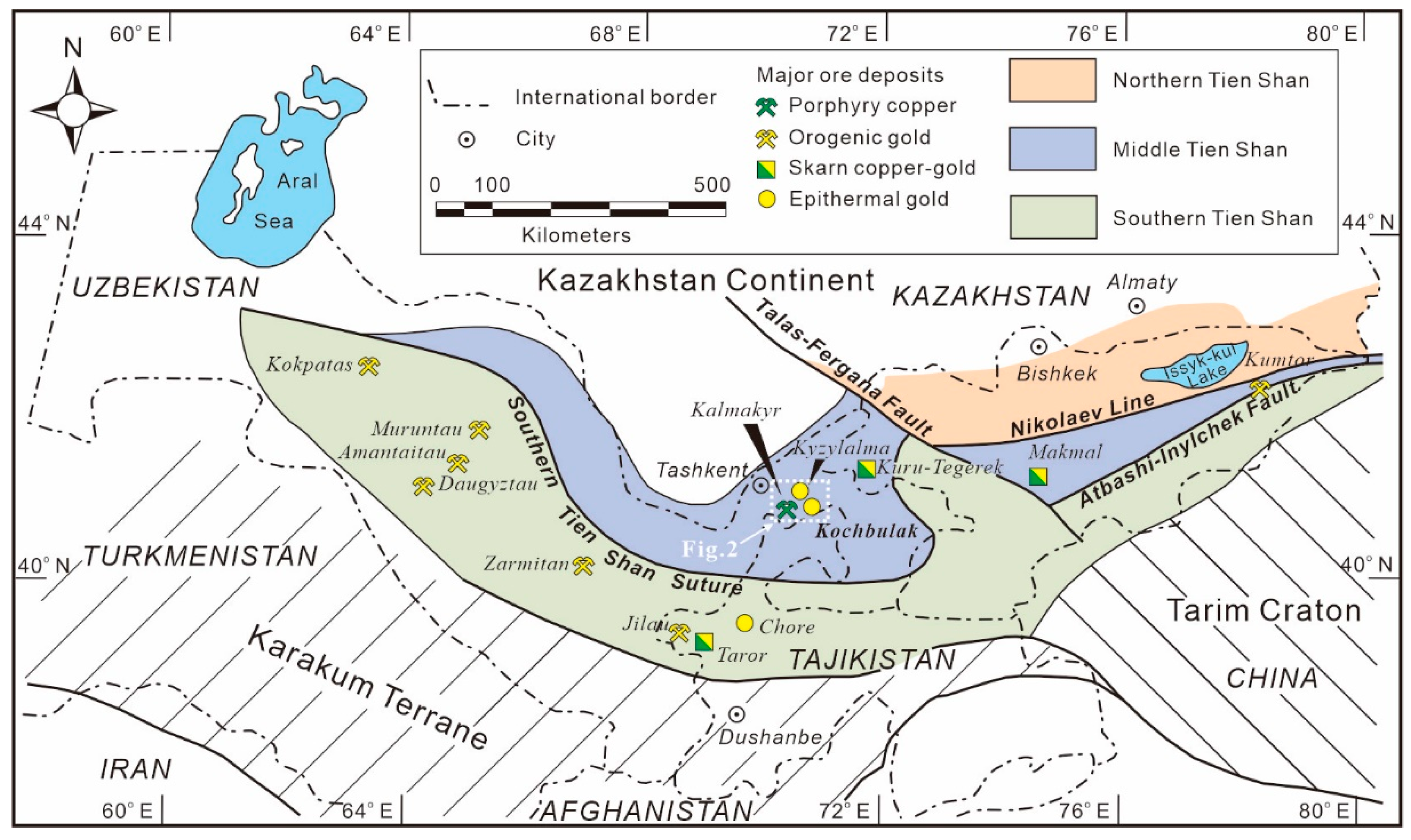
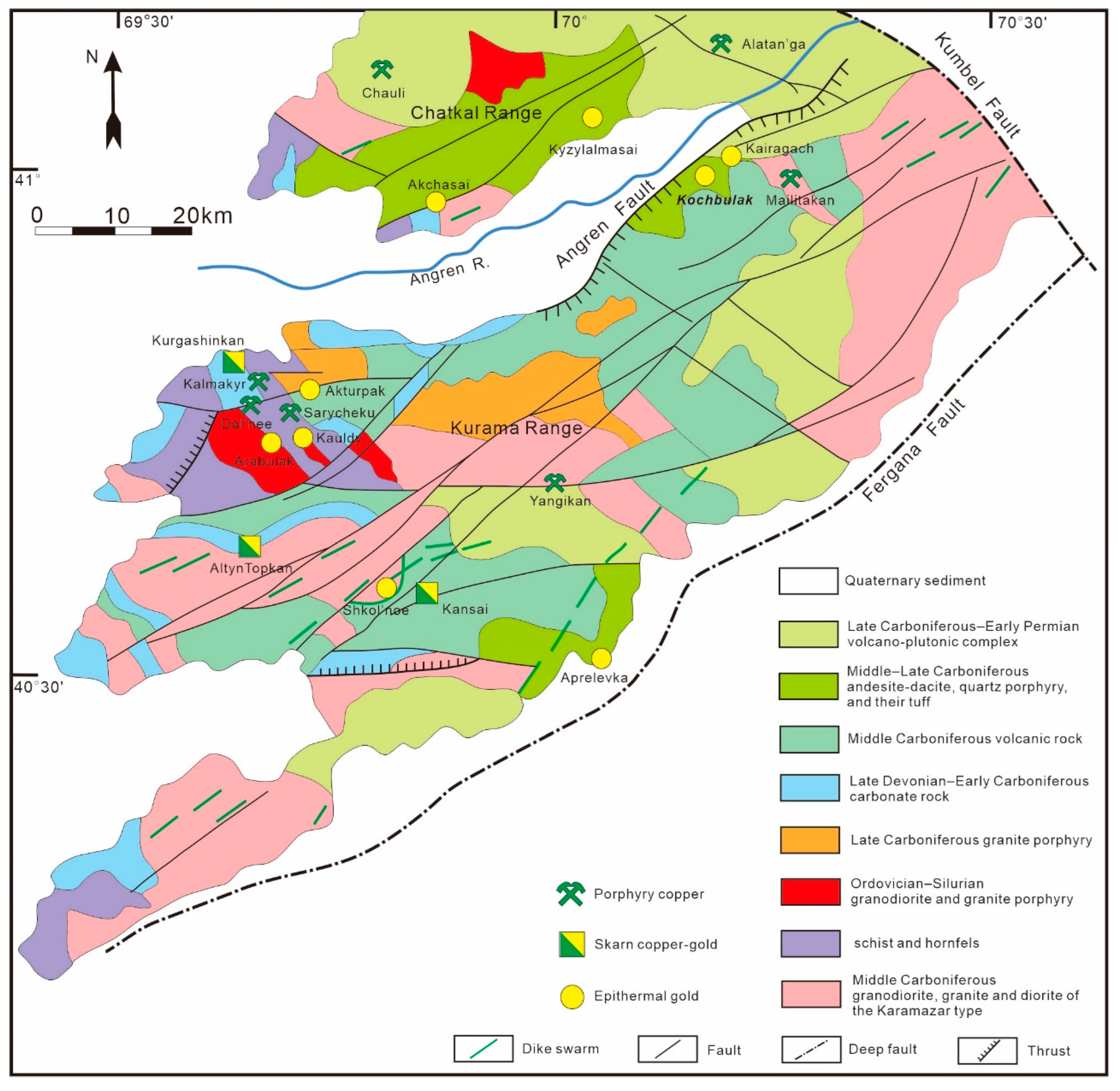

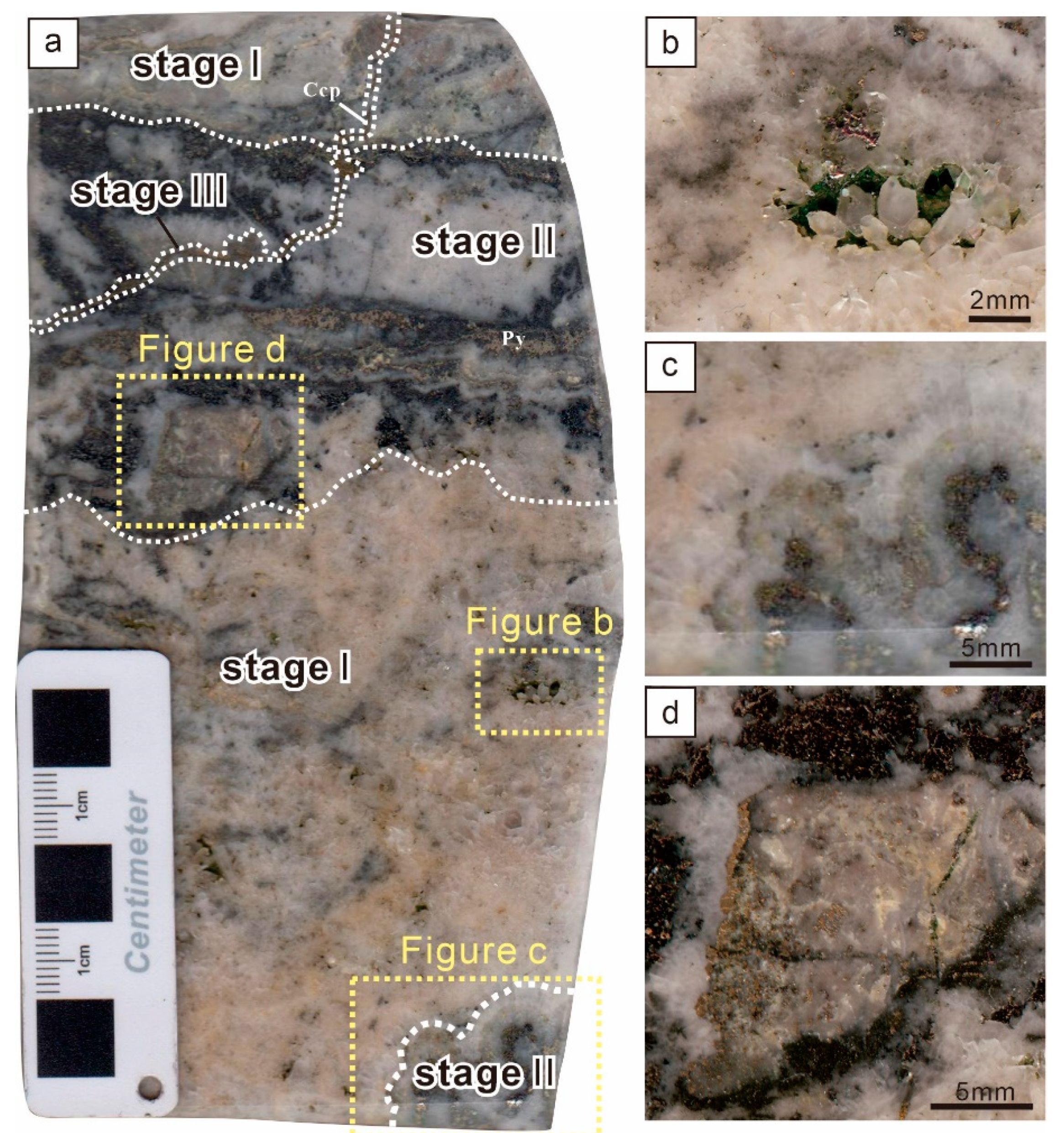

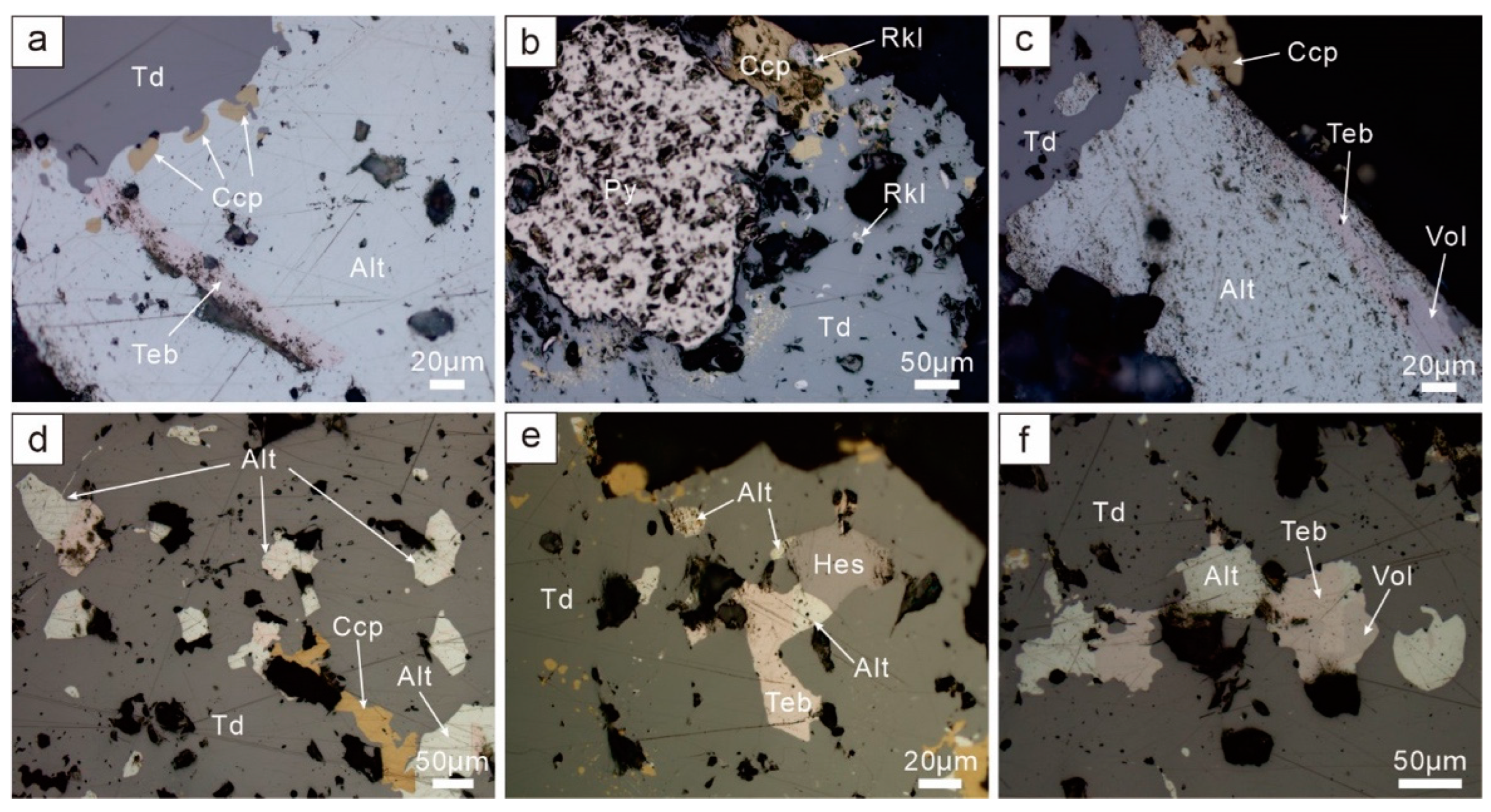

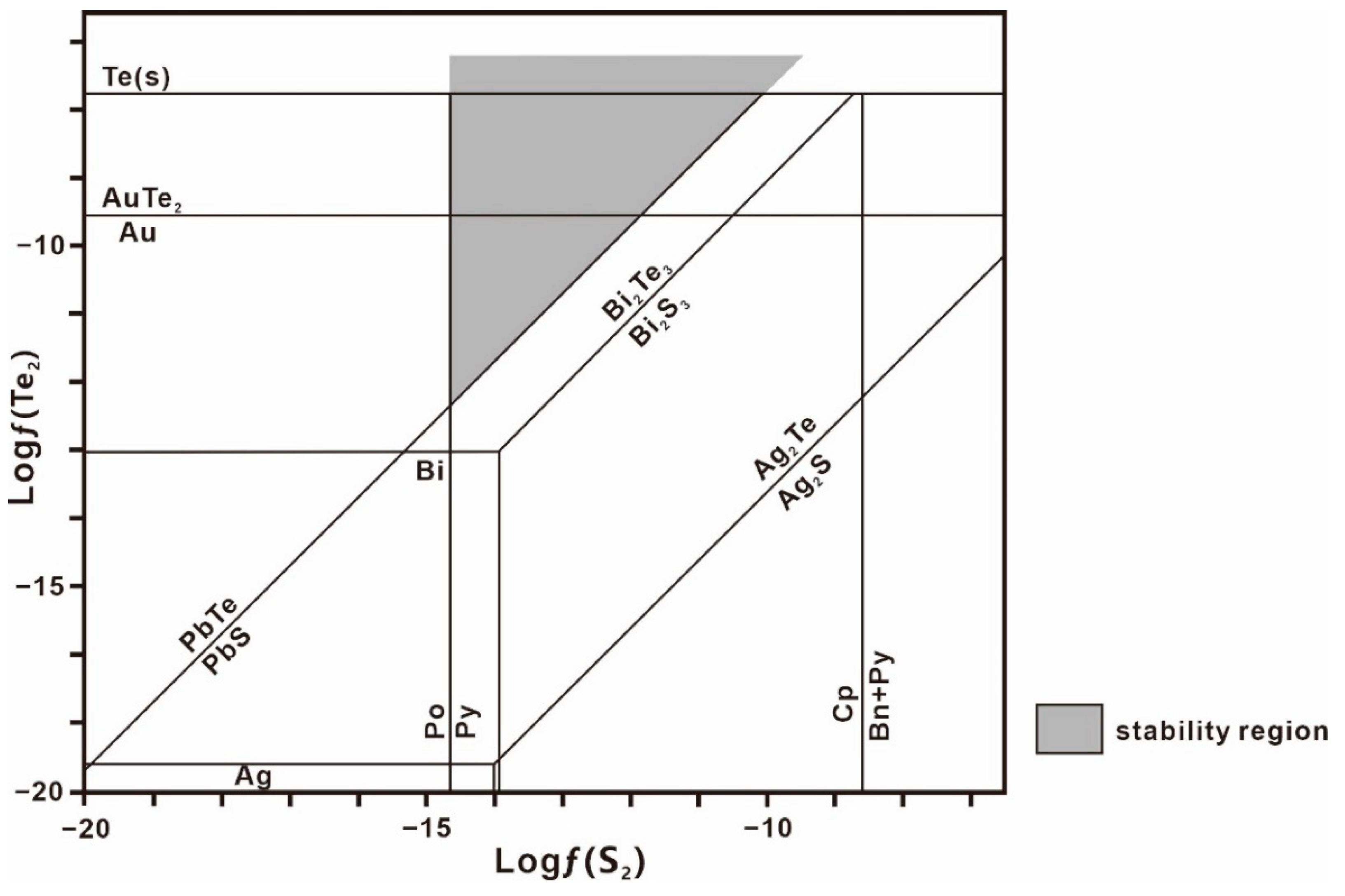
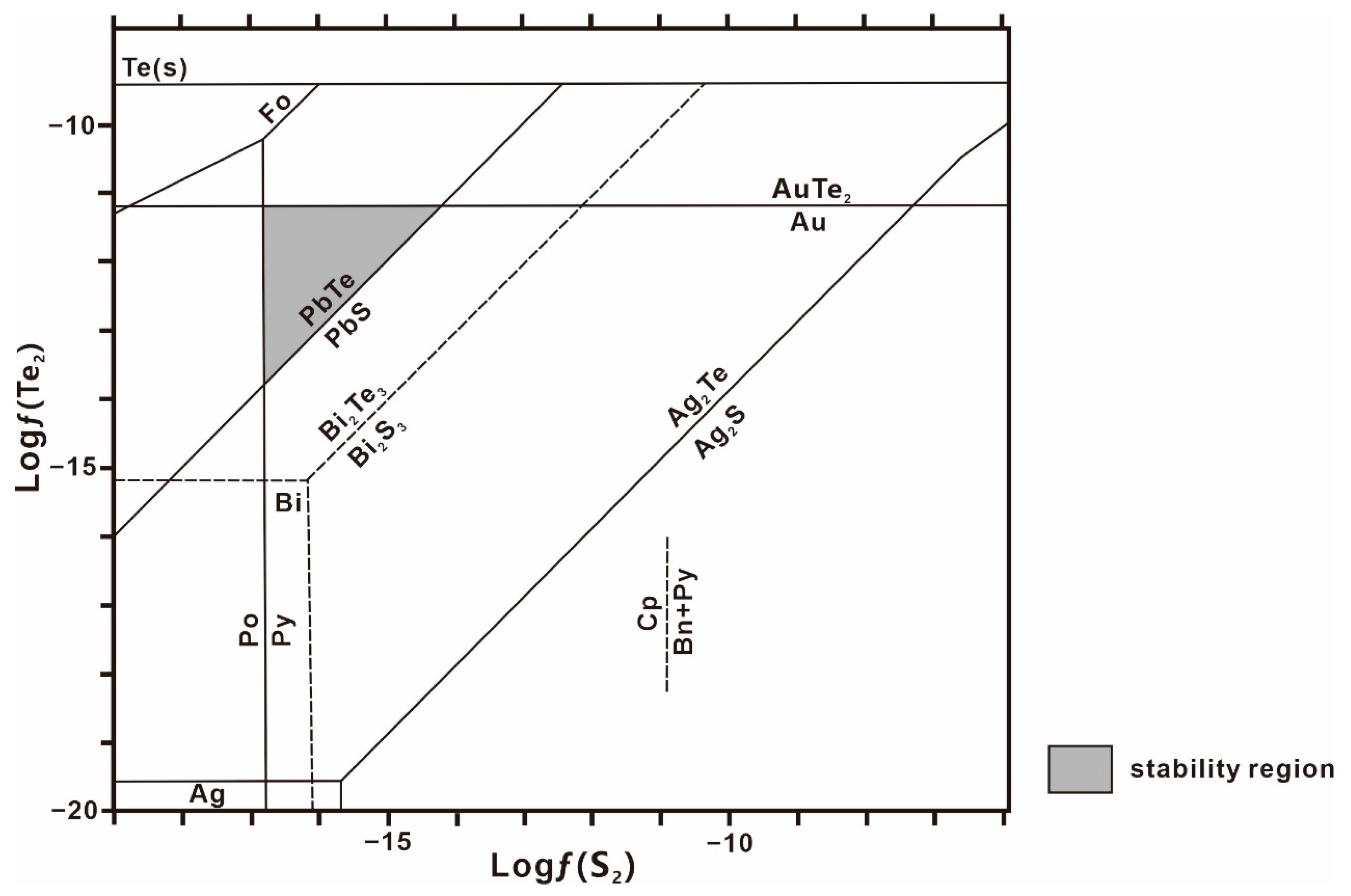
| Mineral | Sample No. | Se | Bi | Te | Mo | Au | Pb | Sb | Ag | S | Total |
|---|---|---|---|---|---|---|---|---|---|---|---|
| Tetradymite | KB-1-1-91 | 1.67 | 54.45 | 36.33 | b.d. | b.d. | b.d. | b.d. | 0.12 | 3.68 | 96.25 |
| KB-1-1-92 | 1.54 | 55.81 | 34.67 | b.d. | b.d. | b.d. | b.d. | b.d. | 3.58 | 95.60 | |
| KB-1-1-93 | 1.55 | 56.21 | 35.27 | b.d. | b.d. | b.d. | b.d. | 0.09 | 3.64 | 96.76 | |
| KB-1-1-94 | 1.67 | 54.59 | 35.08 | b.d. | b.d. | b.d. | b.d. | b.d. | 3.52 | 94.86 | |
| KB-1-1-95 | 1.58 | 56.06 | 36.29 | b.d. | b.d. | b.d. | b.d. | b.d. | 3.26 | 97.19 | |
| Altaite | KB-1-1-30 | 0.60 | 0.81 | 35.69 | b.d. | b.d. | 61.08 | b.d. | 0.31 | b.d. | 98.49 |
| KB-1-1-37 | b.d. | 0.21 | 37.95 | b.d. | b.d. | 58.37 | b.d. | 0.46 | b.d. | 96.99 | |
| KB-1-1-57 | 0.83 | 0.56 | 36.81 | b.d. | b.d. | 63.04 | b.d. | 0.13 | b.d. | 101.37 | |
| KB-1-1-58 | 0.67 | 3.43 | 38.38 | b.d. | b.d. | 53.75 | 0.41 | 2.86 | 0.08 | 99.58 | |
| KB-1-1-74 | 0.21 | 0.84 | 37.24 | b.d. | b.d. | 58.34 | b.d. | 0.29 | b.d. | 96.92 | |
| KB-1-1-75 | 0.44 | 0.82 | 37.69 | b.d. | b.d. | 60.36 | b.d. | b.d. | b.d. | 99.31 | |
| KB-1-1-78 | 1.04 | 1.08 | 35.75 | b.d. | b.d. | 59.36 | b.d. | 1.09 | 0.16 | 98.48 | |
| KB-1-1-84 | 0.18 | 0.38 | 38.36 | b.d. | b.d. | 59.46 | b.d. | 0.19 | b.d. | 98.56 | |
| KB-3-1-101A | 0.29 | 0.94 | 38.44 | b.d. | b.d. | 60.71 | b.d. | 0.30 | b.d. | 100.69 | |
| KB-3-1-103 | 0.33 | 1.01 | 38.15 | b.d. | b.d. | 61.07 | b.d. | 0.32 | b.d. | 100.87 | |
| KB-3-1-104 | 0.43 | 1.39 | 38.24 | b.d. | b.d. | 58.89 | b.d. | 0.91 | b.d. | 99.86 | |
| KB-3-1-104A | 0.25 | 0.57 | 37.40 | b.d. | b.d. | 59.85 | b.d. | 0.55 | b.d. | 98.61 | |
| KB-3-1-105 | 0.29 | 1.18 | 38.42 | b.d. | b.d. | 58.92 | b.d. | 0.48 | b.d. | 99.30 | |
| KB-3-1-106A | 0.24 | 0.57 | 38.23 | b.d. | b.d. | 60.26 | b.d. | 0.22 | b.d. | 99.53 | |
| KB-3-1-106 | 0.17 | 1.69 | 38.15 | b.d. | b.d. | 57.54 | b.d. | 0.62 | b.d. | 98.17 | |
| KB-3-1-107 | 0.25 | 2.04 | 38.86 | b.d. | b.d. | 56.46 | b.d. | 0.99 | b.d. | 98.60 | |
| KB-3-1-108 | 0.19 | 0.88 | 37.77 | b.d. | b.d. | 59.36 | b.d. | 0.19 | b.d. | 98.39 | |
| KB-3-1-109 | 0.35 | 0.53 | 38.13 | b.d. | b.d. | 59.99 | b.d. | 0.27 | b.d. | 99.27 | |
| KB-3-1-109A | 0.18 | 0.50 | 38.12 | b.d. | b.d. | 60.62 | b.d. | 0.09 | b.d. | 99.51 | |
| KB-3-1-111 | b.d. | 1.80 | 38.88 | b.d. | b.d. | 58.26 | b.d. | 0.26 | b.d. | 99.20 | |
| Mineral | Sample No. | Se | Bi | Te | Mo | Au | Pb | Sb | Ag | S | Total |
| Altaite | KB-3-1-112 | 0.11 | 0.58 | 38.48 | b.d. | b.d. | 60.92 | b.d. | 0.22 | b.d. | 100.31 |
| KB-3-1-112A | b.d. | 0.54 | 38.10 | b.d. | b.d. | 59.83 | b.d. | 0.35 | b.d. | 98.82 | |
| KB-3-1-112B | b.d. | 0.66 | 38.51 | b.d. | b.d. | 61.25 | b.d. | 0.16 | b.d. | 100.58 | |
| KB-3-1-112C | b.d. | 0.60 | 39.23 | b.d. | b.d. | 60.24 | b.d. | 0.25 | b.d. | 100.32 | |
| KB-3-1-113 | 0.10 | 0.81 | 38.39 | b.d. | b.d. | 60.02 | b.d. | 0.24 | b.d. | 99.56 | |
| KB-3-1-114 | 0.20 | 0.68 | 37.68 | b.d. | b.d. | 60.06 | b.d. | 0.22 | b.d. | 98.84 | |
| KB-3-1-115 | 0.19 | 0.57 | 37.61 | b.d. | b.d. | 60.86 | b.d. | 0.17 | b.d. | 99.40 | |
| KB-3-1-116 | b.d. | 0.82 | 38.09 | b.d. | b.d. | 60.22 | b.d. | 0.20 | b.d. | 99.33 | |
| KB-3-1-117 | 0.29 | 0.66 | 37.99 | b.d. | b.d. | 59.87 | b.d. | 0.15 | b.d. | 98.96 | |
| KB-3-1-120 | 0.17 | 0.52 | 36.83 | b.d. | b.d. | 60.82 | b.d. | 0.21 | b.d. | 98.55 | |
| KB-3-1-121 | 0.25 | 0.79 | 37.64 | b.d. | b.d. | 60.05 | b.d. | 0.24 | b.d. | 98.97 | |
| KB-3-1-122 | 0.48 | 0.76 | 36.89 | b.d. | b.d. | 60.77 | b.d. | 0.13 | b.d. | 99.02 | |
| KB-3-1-123 | 0.42 | 0.70 | 37.63 | b.d. | b.d. | 59.41 | b.d. | 0.16 | b.d. | 98.33 | |
| Tellurobismuthite | KB-1-1-9 | 0.27 | 47.16 | 46.39 | b.d. | b.d. | b.d. | b.d. | 0.13 | 0.15 | 94.10 |
| KB-1-1-66 | 0.33 | 44.80 | 46.28 | b.d. | b.d. | 4.10 | 2.30 | 0.21 | 0.09 | 98.11 | |
| Rucklidgeite | KB-3-1-118 | b.d. | 41.04 | 46.10 | b.d. | b.d. | 11.25 | 0.40 | 0.23 | b.d. | 99.02 |
| Stützite | KB-36-2-2 | 0.06 | b.d. | 39.85 | b.d. | 0.09 | b.d. | b.d. | 60.14 | 0.00 | 100.26 |
| KB-36-5-2 | 0.11 | 0.08 | 39.39 | b.d. | 6.96 | b.d. | b.d. | 51.35 | 0.05 | 99.20 |
Disclaimer/Publisher’s Note: The statements, opinions and data contained in all publications are solely those of the individual author(s) and contributor(s) and not of MDPI and/or the editor(s). MDPI and/or the editor(s) disclaim responsibility for any injury to people or property resulting from any ideas, methods, instructions or products referred to in the content. |
© 2024 by the authors. Licensee MDPI, Basel, Switzerland. This article is an open access article distributed under the terms and conditions of the Creative Commons Attribution (CC BY) license (https://creativecommons.org/licenses/by/4.0/).
Share and Cite
Lu, Y.; Zhao, X.; Xue, C.; Nurtaev, B.; Shi, Y.; Liu, Y.; Shukurov, S. Telluride Mineralogy of the Kochbulak Epithermal Gold Deposit, Tien Shan, Eastern Uzbekistan. Minerals 2024, 14, 730. https://doi.org/10.3390/min14070730
Lu Y, Zhao X, Xue C, Nurtaev B, Shi Y, Liu Y, Shukurov S. Telluride Mineralogy of the Kochbulak Epithermal Gold Deposit, Tien Shan, Eastern Uzbekistan. Minerals. 2024; 14(7):730. https://doi.org/10.3390/min14070730
Chicago/Turabian StyleLu, Yongwei, Xiaobo Zhao, Chunji Xue, Bakhtiar Nurtaev, Yiwei Shi, Yangtao Liu, and Shukhrat Shukurov. 2024. "Telluride Mineralogy of the Kochbulak Epithermal Gold Deposit, Tien Shan, Eastern Uzbekistan" Minerals 14, no. 7: 730. https://doi.org/10.3390/min14070730





